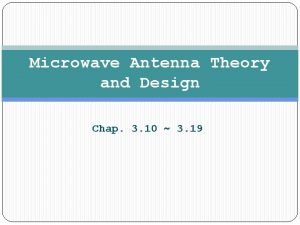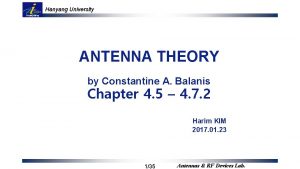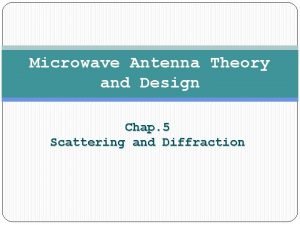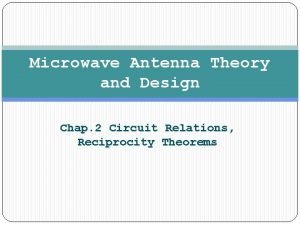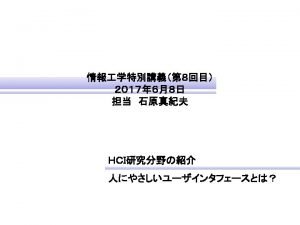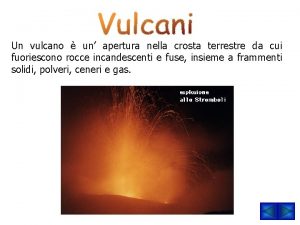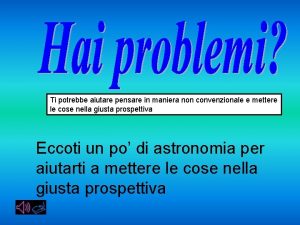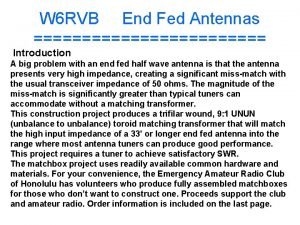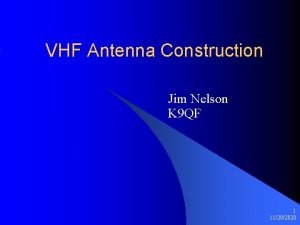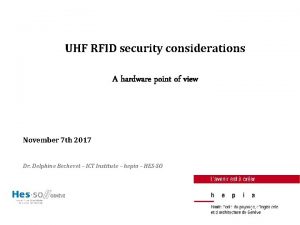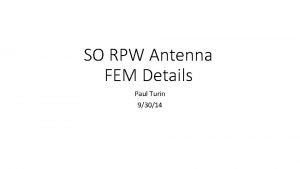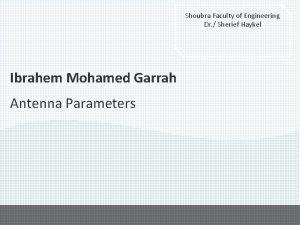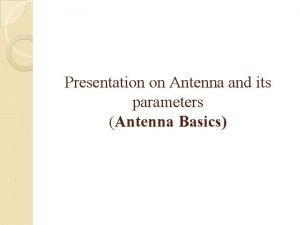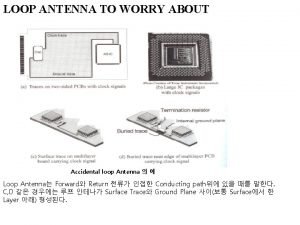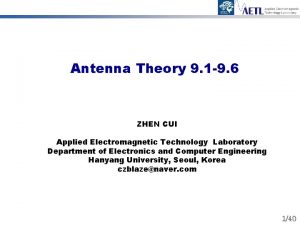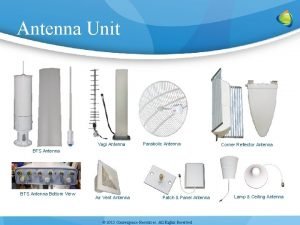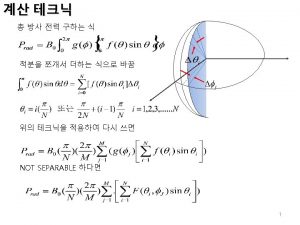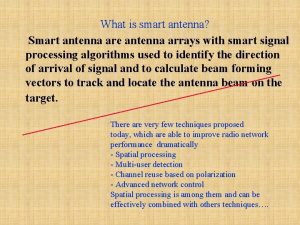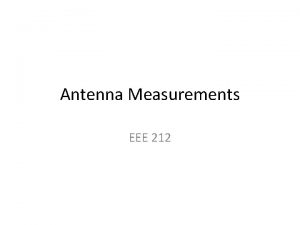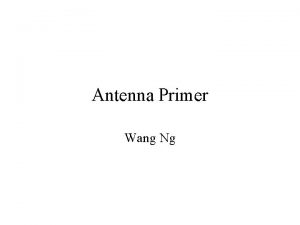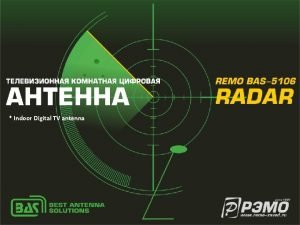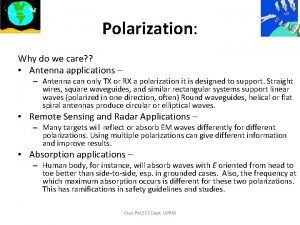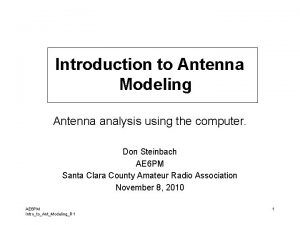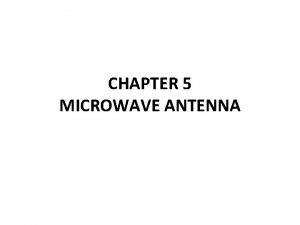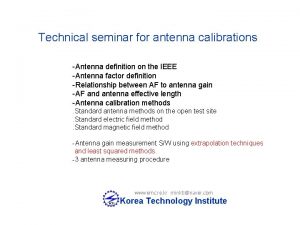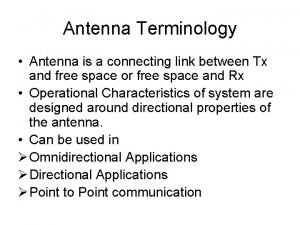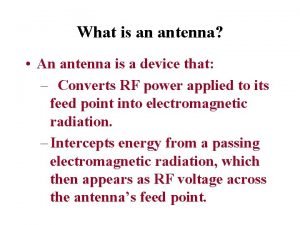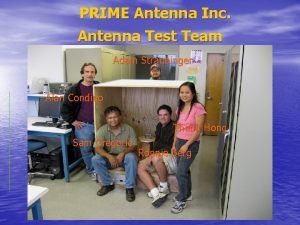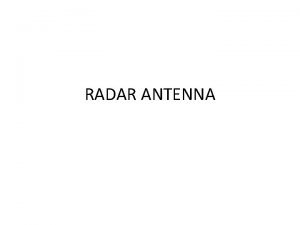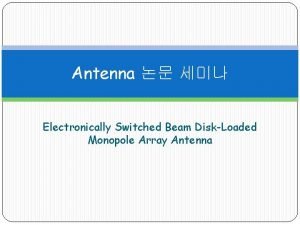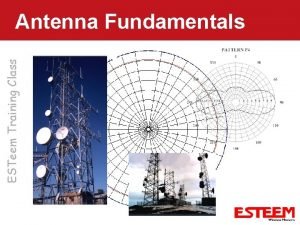Antenna Theory 4 1 4 6 ZHEN CUI








































- Slides: 40

Antenna Theory 4. 1 -4. 6 ZHEN CUI Applied Electromagnetic Technology Laboratory Department of Electronics and Computer Engineering Hanyang University, Seoul, Korea czblaze@naver. com 1/40

Outline q Introduction q Infinitesimal dipole q Small dipole q Region separation q Finite length dipole q Half-wavelength dipole 2/40

Introduction • Wire antennas, linear or curved, are some of the oldest, simplest, cheapest, and in many cases the most versatile for many applications. • We begin our analysis of antennas by considering some of the oldest, simplest, and most basic configurations. • Initially we will try to minimize the complexity of the antenna structure and geometry to keep the mathematical details to a minimum. 3/40

Infinitesimal dipole • • An infinitesimal linear wire (l << λ) is positioned symmetrically at the origin of the coordinate system and oriented along the z axis, as shown in Figure 4. 1(a). • The end plates are used to provide capacitive loading in order to maintain the current on the dipole nearly uniform. • Since the end plates are assumed to be small, their radiation is usually negligible. The wire, in addition to being very small (l << λ), is very thin (a << λ). The spatial variation of the current is assumed to be constant and given by where I 0 = constant 4/40

Radiated Fields • Since the source only carries an electric current Ie, Im and the potential function F are zero. (x, y, z ) : the observation point coordinates (x’ , y’ , z’ ) represent the coordinates of the source R: the distance from any point on the source to the observation point path C is along the length of the source • so we can write (4 -2) as 5/40

Radiated Fields • The next step of the procedure is to find HA using (3 -2 a) and then EA using (3 -15) or (3 -10) with J = 0. • It is often much simpler to transform (4 - 4) from rectangular to spherical components and then use (3 -2 a) and (3 -15) or (3 -10) in spherical coordinates to find H and E. • The transformation between rectangular and spherical components in matrix form: • For this problem, Ax = Ay =0 6/40

Radiated Fields • Using the symmetry of the problem (no φ variations), (3 -2 a) can be expanded in spherical coordinates and written in simplified form as • Substituting (4 -6 a)–(4 -6 c) into (4 -7) reduces it to • The electric field E can now be found using (3 -15) or (3 -10) with J = 0. • Substituting (4 -6 a)–(4 -6 c) or (4 -8 a)–(4 -8 b) into (4 -9) reduces it to 7/40

Power Density and Radiation Resistance • For the infinitesimal dipole, the complex Poynting vector can be written using (4 -8 a)– (4 -8 b) and (4 -10 a)–(4 -10 c) as • whose radial Wr and transverse Wθ components are given, respectively, by 8/40

Power Density and Radiation Resistance • The complex power moving in the radial direction can be written as • Equation (4 -13), which gives the real and imaginary power that is moving outwardly, can also be written as 9/40

Power Density and Radiation Resistance • Since the antenna radiates its real power through the radiation resistance, for the infinitesimal dipole: • Radiation resistance R: • It should be pointed out that the radiation resistance of (4 -19) represents the total radiation resistance since (4 -12 b) does not contribute to it. 10/40

Radian Distance and Radian Sphere • The E- and H-fields for the infinitesimal dipole, as represented by • Radian distance r = λ/2π (kr =1) • Near-field region r < λ/2π (kr <1) • Intermediate-field region r > λ/2π (kr >1) • • Far-field region r >> λ/2π (kr >>1) Radian sphere Sphere radius = r = λ/2π11/40

Near-Field (kr << 1) Region • • The E-field components, Er and Eθ , are in timephase but they are in time-phase quadrature with the H-field component Hφ; therefore there is no time-average power flow associated with them. Time-average power density which by using (4 -20 a)–(4 -20 d) reduces to • Equations (4 -20 a) and (4 -20 b) are similar to those of a static electric dipole and (420 d) to that of a static current element. • Thus we usually refer to (4 -20 a)–(4 -20 d) as the quasistationary fields. 12/40

Intermediate-Field (kr > 1) Region • The total electric field whose magnitude can be written as 13/40

Far-Field (kr >> 1) Region • The ratio of Eθ to Hφ is equal to • The E- and H-field components are perpendicular to each other, transverse to the radial direction of propagation, and the r variations are separable from those of θ and φ. The fields form a Transverse Electro. Magnetic (TEM) wave whose wave impedance is equal to the intrinsic impedance of the medium. • 14/40

Directivity • Average power density • Radiation intensity U • The maximum value occurs at θ = π/2 • Directivity • Maximum effective aperture 15/40

Small dipole • The radiation properties of an infinitesimal dipole, which is usually taken to have a length l ≤ λ/50, were discussed in the previous section. Its current distribution was assumed to be constant. • A better approximation of the current distribution of wire antennas, whose lengths are usually λ/50 < l ≤ λ/10, is the triangular variation of Figure 1. 16(a). The sinusoidal variations of Figures 1. 16(b)–(c) are more accurate representations of the current distribution of any length wire antenna. 16/40

Small dipole • The current distribution of a small dipole (λ/50 < l ≤ λ/10): where I 0 = constant 17/40

Small dipole • The vector potential: • Because the overall length of the dipole is very small (usually l ≤ λ/10), the values of R for different values of z along the length of the wire (−l/2 ≤ z ≤ l/2) are not much different from r. Thus R can be approximated by R ≈ r through out the integration path. Performing the integration, (4 -34) reduces to • which is one-half of that obtained in the previous section for the infinitesimal dipole and given by (4 -4). 18/40

Small dipole • Since the potential function for the triangular distribution is one-half of the corresponding one for the constant (uniform) current distribution, the corresponding fields of the former are one-half of the latter. • The E and H-fields radiated by a small dipole as • The radiation resistance of the antenna is strongly dependent upon the current distribution. 19/40

Region separation • A very thin dipole of finite length l is symmetrically positioned about the origin with its length directed along the z-axis, as shown in Figure 4. 5(a). 20/40

Region separation • The wire is assumed to be very thin (x’ = y’ =0) where • Using the binomial expansion, we can write (4 -40) in a series as 21/40

Region separation where D is the largest dimension of the antenna (D = l for a wire antenna). 22/40

Finite length dipole • For a very thin dipole (ideally zero diameter), the current distribution can be written, to a good approximation, as • Electric and Magnetic field components (far -field) 23/40

Finite length dipole • Using the far-field approximations given by (4 -46), (4 -57 a) can be written as • Summing the contributions from all the infinitesimal elements • The total field of the antenna is equal to the product of the element and space factors • For the current distribution of (4 -56), (4 -58 a) can be written as 24/40

Finite length dipole • Each one of the integrals in (4 -60) can be integrated using • After some mathematical manipulations, (4 -60) takes the form of • In a similar manner, the total Hφ component can be written as 25/40

Power Density, Radiation Intensity, and Radiation Resistance • For the dipole, the average Poynting vector can be written as • The radiation intensity 26/40

Power Density, Radiation Intensity, and Radiation Resistance • The normalized (to 0 d. B) elevation power patterns, as given by (4 -64) for l = λ/4, λ/2, 3λ/4, and λ are shown plotted in Figure 4. 6. • As the length of the antenna increases, the beam becomes narrower. 27/40

Power Density, Radiation Intensity, and Radiation Resistance • As the length of the dipole increases beyond one wavelength (l > λ), the number of lobes begin to increase. • The normalized power pattern for a dipole with l = 1. 25λ is shown in Figure 4. 7. 28/40

Power Density, Radiation Intensity, and Radiation Resistance • The current distribution for the dipoles with l = λ/4, λ/2, λ, 3λ/2, and 2λ, as given by (4 -56), is shown in Figure 4. 8. 29/40

Power Density, Radiation Intensity, and Radiation Resistance • To find the total power radiated, the average Poynting vector of (4 -63) is integrated over a sphere of radius r. • Using (4 -63), we can write (4 -66) as 30/40

Power Density, Radiation Intensity, and Radiation Resistance • After some extensive mathematical manipulations, it can be shown that (4 -67) reduces to where C = 0. 5772 (Euler’s constant) and Ci(x) and Si(x) are the cosine and sine integrals • Ci(x) is related to Cin(x) by where 31/40

Power Density, Radiation Intensity, and Radiation Resistance • The radiation resistance can be obtained using (4 -18) and (4 -68) and can be written as • Shown in Figure 4. 9 is a plot of Rr as a function of l (in wave lengths) when the antenna is radiating into free-space (η = 120π). 32/40

Power Density, Radiation Intensity, and Radiation Resistance • The imaginary part of the impedance, relative to the current maximum, is given by • To examine the effect the wire radius has on the values of the reactance, its values, as given by (4 -70 a), are plotted in Figure 4. 9(b) for a = 10− 5λ, 10− 4λ, 10− 3λ, and 10− 2λ. 33/40

Directivity • The directivity was defined mathematically by • The radiation intensity U • From (4 -64), the dipole antenna of length l has • Because the pattern is not a function of φ, (4 -71) reduces to • The corresponding values of the maximum effective aperture are related to the directivity by 34/40

Input Resistance • To refer the radiation resistance to the input terminals of the antenna, the antenna itself is first assumed to be lossless (RL = 0). Then the power at the input terminals is equated to the power at the current maximum. • Referring to Figure 4. 10, we can write • For a dipole of length l, the current at the input terminals (Iin ) is related to the current maximum (I 0) referring to Figure 4. 10, by • Thus the input radiation resistance of (4 -77 a) can be written as 35/40

Finite Feed Gap • To analytically account for a nonzero current at the feed point for antennas with a finite gap at the terminals, Schelkunoff and Friis [6] have changed the current of (456) by including a quadrature term in the distribution. • The additional term is inserted to take into account the effects of radiation on the antenna current distribution. • This reaction is included by modifying (4 -56) to • where p is a coefficient that is dependent upon the overall length of the antenna and the gap spacing at the terminals. The values of p become smaller as the radius of the wire and the gap decrease. 36/40

Half-wavelength dipole • The electric and magnetic field components of a half-wavelength dipole can be obtained from (4 -62 a) and (4 -62 b) by letting l = λ/2. • The time-average power density • Radiation intensity 37/40

Half-wavelength dipole • The total power radiated canbe obtained as a special case of (4 -67) • which when integrated reduces, as a special case of (468), to 38/40

Half-wavelength dipole • By the definition of Cin(x), as given by (4 -69), Cin (2π) is equal to • The maximum directivity of the half-wavelength dipole reduces to • The corresponding maximum effective area is equal to 39/40

Half-wavelength dipole • The radiation resistance, for a free-space medium (η = 120π), is given by • The total input impedance for l = λ/2 is equal to • Depending on the radius of the wire, the length of the dipole for first resonance is about l = 0. 47λ to 0. 48λ; the thinner the wire, the closer the length is to 0. 48λ. Thus, for thicker wires, a larger segment of the wire has to be removed from λ/2 to achieve resonance. 40/40
 Zhen jiang actor
Zhen jiang actor Zhen gu
Zhen gu Ugvr
Ugvr Cis 1068
Cis 1068 Zhen._.nnnn
Zhen._.nnnn Eh antenna
Eh antenna Microwave antenna theory and design
Microwave antenna theory and design Finite length dipole antenna
Finite length dipole antenna Microwave antenna theory and design
Microwave antenna theory and design Microwave antenna theory and design
Microwave antenna theory and design Gui programing
Gui programing Ruby gui
Ruby gui Cui marking example
Cui marking example Chestermere recycle depot
Chestermere recycle depot Teng cui
Teng cui Lisa cui
Lisa cui Hanno un aspetto spugnoso e forma conica
Hanno un aspetto spugnoso e forma conica Fessure del suolo da cui esce vapore
Fessure del suolo da cui esce vapore Cui umls
Cui umls 13556
13556 Cui timetable
Cui timetable Ci sono momenti nella vita
Ci sono momenti nella vita Mentre chi rovinava in basso loco parafrasi
Mentre chi rovinava in basso loco parafrasi Cui
Cui Piante il cui seme è racchiuso in un frutto
Piante il cui seme è racchiuso in un frutto E poi ci sono quei momenti in cui pensi
E poi ci sono quei momenti in cui pensi Cuifar
Cuifar Cui commands
Cui commands Questa è la notte in cui cristo ha distrutto la morte
Questa è la notte in cui cristo ha distrutto la morte Army unauthorized disclosure training
Army unauthorized disclosure training Stable prediction across unknown environments
Stable prediction across unknown environments Cui chestermere
Cui chestermere Sfs bowls
Sfs bowls Rvb the end
Rvb the end Nelson antenna
Nelson antenna Rfid antenna
Rfid antenna Paul turin
Paul turin Radiation intensity of antenna
Radiation intensity of antenna Basic antenna parameters
Basic antenna parameters Microwave path alignment
Microwave path alignment Accidental loop
Accidental loop






